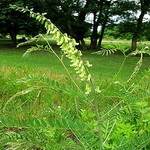| Common Name: |
Yellow Pagoda Tree |
| Botanical Name: |
Sophora flavescens |
| Genus: |
Sophora |
| Family: |
Papilionaceae |
| Native Location: |
Japan, China, Siberia, and Korea |
| Cultivation: |
Well-drained soil in sun. |
| Propagation: |
By seed sown when ripe (species only); by grafting in late winter (cultivars of S. japonica). . |
| Harvest: |
Roots (S. flavescens) are lifted in autumn. Flowers and flower buds (S. japonica) are picked in late summer. Fruits are collected in autumn. All parts are dried for use in decoctions. |
| Height: |
1.5m (5ft) |
| Width: |
2m (6ft) |
| Hardiness: |
Z6 |
| Parts Used: |
Roots (ku shen) |
| Properties: |
A bitter, cooling, diuretic herb that controls itching and has anti-bacterial, anti-fungal, and anti-tumor effects. |
| Medicinal Uses: |
Internally for jaundice, dysentery, diarrhea, and urinary infections. Internally and externally for vaginitis, eczema, pruritis, ringworm, leprosy, syphilis, scabies, and itching allergic reactions. |
| Bibliography: |
Encyclopedia of Herbs by Deni Brown Copyright © 1995, 2001 Dorling Kindersley Limited. pg 372 |

